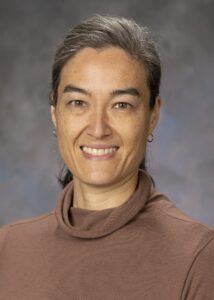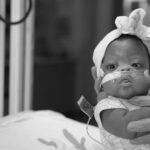Meet Toni Pearson, MD: Pediatric Movement Disorders Expert
Meet Toni Pearson, MD: Pediatric Movement Disorders Expert https://pediatricsnationwide.org/wp-content/themes/corpus/images/empty/thumbnail.jpg 150 150 Pam Georgiana Pam Georgiana https://pediatricsnationwide.org/wp-content/uploads/2023/07/May-2023.jpg- January 29, 2024
- Pam Georgiana
Toni S. Pearson, MD, joined Nationwide Children’s in 2022 as an attending pediatric neurologist and professor of pediatrics at The Ohio State University College of Medicine. She specializes in childhood movement disorders, such as dystonia, chorea, parkinsonism, ataxia, myoclonus, tremors, tics, and spasticity. Dr. Pearson is also developing a fellowship training program for a new subspeciality in pediatric movement disorders (PMD) at Nationwide Children’s.

Toni Pearson, MD
In a Q&A, Dr. Pearson shares her thoughts about how genetic research can revolutionize the treatment of PMD and how subspecialty training in PMD is needed to treat kids with these conditions.
What are movement disorders?
Movement disorders include conditions that cause involuntary movements such as tics, dystonia, chorea, tremor, and myoclonus, as well as atypical motor control and development. These symptoms are related to how the brain controls movement. Some PMDs are genetic, and some are the results of brain injury or other causes, such as medications or inflammatory disorders. The most common PMDs are those associated with cerebral palsy. Yet, we are still discovering the underlying causes of genetic PMDs, many of which are rare. The better we understand how PMDs develop, the better we can determine the most optimal treatments that address both symptoms and the underlying disease.
What inspired you to specialize in pediatric movement disorders?
As a resident, I cared for several patients with PMD. One particular patient had a really rare form of pediatric parkinsonism. This patient’s care was very challenging, and there was little research to help inform treatment.
When I finished my neurology training about 15 years ago, I found very few neurologists trained in PMD-specific conditions. I had to start all over again in fellowship, learning how to diagnose, treat, and manage these specific conditions. It was a whole new vocabulary and approach to patient care. Today, there is a small but growing community of PMD-trained neurologists. It’s a relatively new and very exciting subspecialty of neurology. That is why my research is so important.
How did your research bring you to Nationwide Children’s Hospital?
I moved to Columbus from Washington University in St. Louis to further my work with a research team led by Krystof Bankiewicz, MD, PhD at The Ohio State University College of Medicine, investigating gene therapy for the neurotransmitter disorder aromatic L-amino acid decarboxylase (AADC) deficiency. AADC deficiency is an ultra-rare genetic disease. It causes deficient synthesis of dopamine and serotonin in the brain and presents with symptoms during the first months of life. AADC deficiency results in significant developmental delays and lifelong motor, behavioral, and autonomic symptoms. Our clinical trials focus on the safety and efficacy of gene therapy in patients with AADC deficiency. We are also documenting any restoration of brain AADC activity. Our team published the results of treatment of our first seven patients in Nature Communications in 2021.
How has your research impacted the clinical care of children with PMD?
Clinical trials like ours can make life-changing advancements in treating kids with these diseases. The research is valuable in teaching us how the brain functionally changes and grows at different stages of life. This knowledge can help us to understand the potential for developing optimal therapies and treatments for children based on age and development stage.
What do you hope to bring to your role at Nationwide Children’s?
Aside from developing a focus on PMD in the Neurology Department, I am very aware of a significant clinical need for neurologists trained in PMD. This clinical expertise can be helpful in more effective diagnosis and treatment. I have developed a fellowship program for training movement disorder specialists, and we are actively recruiting residents now. The program will provide residents with advanced clinical, diagnostic, procedural, and management skills that reflect the complexities of PMD. The emergence of new therapies makes the field of neurology (specifically the subspeciality of PMD) a rewarding place to work. I am happy to be a part of Nationwide Children’s contribution to the field.
Reference:
Pearson TS, Gupta N, San Sebastian W, et al. Gene therapy for aromatic L-amino acid decarboxylase deficiency by MR-guided direct delivery of AAV2-AADC to midbrain dopaminergic neurons. Nat Commun. 2021;12(1):4251. doi:10.1038/s41467-021-24524-8
Image credit: Nationwide Children’s
About the author
Pam Georgiana is a brand marketing professional and writer located in Bexley, Ohio. She believes that words bind us together as humans and that the best stories remind us of our humanity. She specialized in telling engaging stories for healthcare, B2B services, and nonprofits using classic storytelling techniques. Pam has earned an MBA in Marketing from Capital University in Columbus, Ohio.
-
Pam Georgianahttps://pediatricsnationwide.org/author/pam-georgiana/
-
Pam Georgianahttps://pediatricsnationwide.org/author/pam-georgiana/
-
Pam Georgianahttps://pediatricsnationwide.org/author/pam-georgiana/
-
Pam Georgianahttps://pediatricsnationwide.org/author/pam-georgiana/August 30, 2023
- Posted In:
- Features










